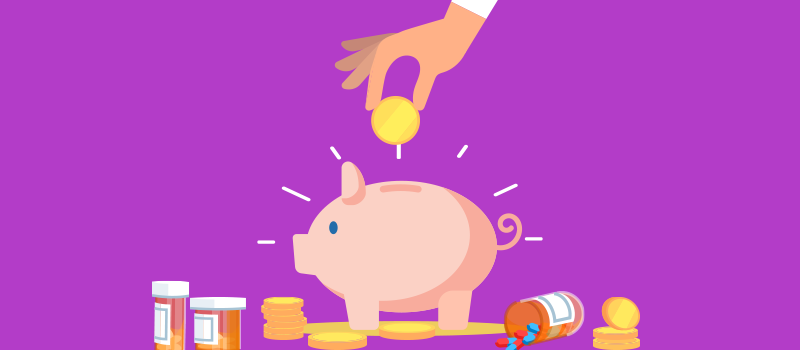What’s the Buzz
The Bee Healthy Blog
How Does Xanax Work for Anxiety?

Xanax is the brand name product for the generic drug alprazolam. It is used to treat anxiety and panic disorders and is the most commonly prescribed psychotropic medication in the United States. Please continue reading to learn more about Xanax, including how it can reduce anxiety and what you should know before taking this medication.
What is Xanax?
Xanax (alprazolam) belongs to a group of prescription medications called benzodiazepines. Other drugs in the same class include diazepam (Valium), lorazepam (Ativan), clonazepam (Klonopin), temazepam (Restoril), and others. Benzodiazepines are Schedule IV controlled substances because of their potential for abuse, physical dependence, and psychological dependence.
What is Xanax used to treat?
The FDA has approved Xanax for the treatment of panic and anxiety disorders, including generalized anxiety disorder and panic disorder with or without agoraphobia (a fear of situations where help may not be available or escape may not be possible).
Doctors prescribe Xanax for short-term relief from anxiety symptoms. It is also an effective medication to treat panic attacks (periods of intense fear). Other uses of Xanax may include premenstrual syndrome.
Other benzodiazepines are used to treat mental health disorders such as social anxiety disorder, sleep problems, spasticity, and epilepsy.
Xanax (alprazolam) and other benzodiazepines like clonazepam (Klonopin) are sold on the illicit drug market and are commonly known as “downers” or “benzos” because of their calming effect and the relaxed feeling they produce. In addition, there is a possibility for people to misuse benzodiazepines by obtaining multiple prescriptions from multiple doctors due to feelings of inadequate treatment or because of desiring the feeling they create. Doctors and pharmacists are able to check drug records even outside of their practice to minimize misuse and effectively treat every patient.
Therefore, it is worth remembering that Xanax is a controlled substance. Taking alprazolam without a doctor’s prescription (misusing or abusing this medication) carries an increased risk of substance abuse, addiction, and overdose.
How does Xanax work to treat anxiety disorders?
Xanax works by enhancing the activity of gamma-aminobutyric acid (GABA), an inhibitory neurotransmitter (a natural chemical in the central nervous system that decreases brain activity). Therefore, Xanax relieves anxiety symptoms and panic attacks by reducing abnormal brain activity.
How long does it take Xanax to stop anxiety?
Xanax works quickly and can provide almost immediate relief from anxiety and panic disorder symptoms. You can usually feel the effects of the medicine within 30-60 minutes. The drug reaches peak concentration in the body 1-2 hours after you take a dose. However, it has a short half-life, and the effects of Xanax wear off quickly, so you may need to take the medication several times a day, depending on your stressors and doctor’s orders.
The usual dose of Xanax for reducing anxiety is 0.25 to 0.5 mg three times a day. This dose may be increased every 3-4 days up to a maximum dose of 4 mg per day. The dose of Xanax for panic disorders is 5-6 mg daily on average, but some patients require up to 10 mg daily.
Can I take Xanax every day for anxiety?
Xanax is for the short-term treatment of anxiety and panic attacks, meaning different medications may be used for longer symptom relief throughout the day. This medicine should be taken at the lowest effective dose. Your medical professional will periodically reassess you and may try reducing your maintenance dose after your symptoms resolve with less medication use.
It’s important to take Xanax exactly as your doctor prescribes. Long-term treatment with this medication can be habit-forming. Suddenly stopping Xanax can cause uncomfortable and potentially life-threatening withdrawal symptoms.
Follow your healthcare professional’s dosing instructions carefully. Do not increase the dose, dosing frequency, or duration of treatment without the approval of your healthcare provider.
What are the risks of taking Xanax?
Side effects
Taking Xanax and other medications from the same class can cause side effects such as drowsiness, dizziness, headache, fatigue, irritability, memory problems, trouble concentrating, changes in appetite, weight changes, nausea, constipation, changes in sex drive, urinary difficulties, and joint pain.
Less commonly, people can develop serious allergic reactions to Xanax. You should call your healthcare provider without delay or seek emergency medical attention if you develop a skin rash, hives, itching, shortness of breath, rapid heartbeat, low blood pressure, confusion, seizures, yellowing of the eyes or skin, and problems with speech, balance, or coordination. Avoid Xanax if you have a history of an allergic reaction to this medicine.
Potential for misuse
Taking Xanax can be habit-forming and cause psychological and physical dependence. Abuse, misuse, and addiction increase the risk of overdose and even death. Tell your doctor if you have a history of drug abuse. Your provider may recommend other treatment options for anxiety and panic disorders.
Withdrawal symptoms
Stopping Xanax suddenly after taking it for a long time can lead to withdrawal. Xanax withdrawals may include behavior changes, sleep problems, hallucinations, and seizures. Your healthcare professional will tell you how to lower the dose slowly.
Sedative effects
Xanax can cause drowsiness and dizziness and affect your ability to concentrate. This can increase your risk of falls, injuries, and accidents. Avoid driving or doing other hazardous activities until you know how it affects you. Remember, drinking alcohol can make these Xanax side effects worse, so it is best to avoid alcohol while on this medicine.
Respiratory depression
Xanax can cause slowed breathing. The risk is higher if you are taking other CNS depressants, such as opioid pain medications. Get medical help without delay if you develop slow or shallow breathing or have extreme sleepiness after taking Xanax.
References:












SOCIAL